New Bentley Motor
Car for HM The Queen
Windsor Castle,
29th May 2002
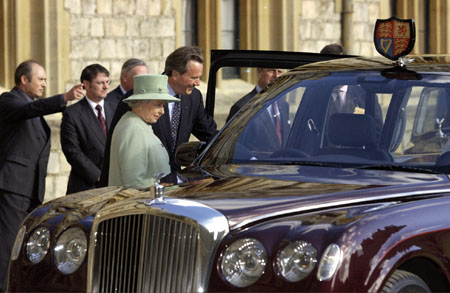
Franz-Josef Paefgen of Bentley
Motors shows the new Bentley State Limousine to HM The Queen
Bentley Motors chairman and chief executive
Franz-Josef Paefgen presented the new Bentley State Limousine
to The Queen at Windsor Castle on 29th May 2002. Presented on
behalf of a consortium of British based automotive manufacturing
and service companies, the Bentley is a gift to The Queen in
recognition of her Golden Jubilee year. The occasion marked an
important milestone in the history of Bentley Motors, and signals
the continuation of the Crewe tradition of supplying fine, bespoke
and beautifully crafted cars for royal occasions.
Work first began on the Bentley State Limousine
in the spring of 2000 after the proposal to build a Bentley for
The Queen, as part of the celebrations for the Golden Jubilee,
was first presented to royal officials.
This was not the first time that Bentley's
craftsmen and women have been involved in building a Royal car.
The most recent, in 1987, was a Rolls-Royce Phantom VI 'standard
limousine.' However, this was preceded by a presentation of a
Rolls-Royce Phantom VI State Limousine to The Queen in recognition
of her Silver Jubilee year. This project was funded by The Society
of Motor Manufacturers and Traders (SMMT). The car was a variation
of an existing Rolls-Royce Phantom VI model, which had been adapted
to accommodate a higher roofline and larger windows for State
use.
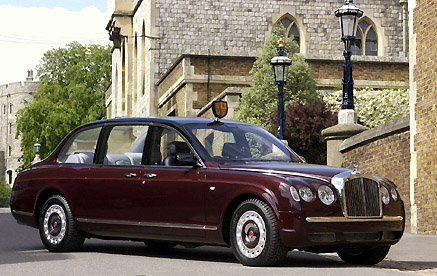
The new Bentley, designed to run
on LPG and specially built for the Queen's use on State occasions,
photographed at Windsor Castle, 29th May 2002
The design and manufacture of today's Bentley
however has been a complete contrast. Uniquely this car has been
designed for State duties, it is also the first ceremonial Royal
vehicle to have been developed using the latest computer aided
design techniques and will be the first ever Bentley in the Royal
fleet.
The new Bentley State Limousine will be used
extensively during The Queen's Golden Jubilee Tour. The first
official journey was on Tuesday, 4th June when the car took The
Queen and The Duke of Edinburgh from the National Service of
Thanksgiving at St Paul's Cathedral, London to a Banquet at London's
Guildhall in the presence of the Lord Mayor of London, Mr Tony
Blair, Prime Minister and many other dignitaries.
The Bentley State Limousine has been built
in the workshops of Bentley Mulliner, the specialist division
of Bentley Motors. With an array of technical and coachbuilding
skills at its disposal, Bentley Mulliner provides a wide variety
of bespoke services for its customers ranging from exotic veneers
inlaid with personalised marquetry to the latest entertainment
and business office facilities.
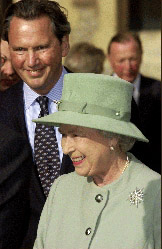 The Queen looks pleased as she
receives the new State Bentley
The Queen looks pleased as she
receives the new State Bentley
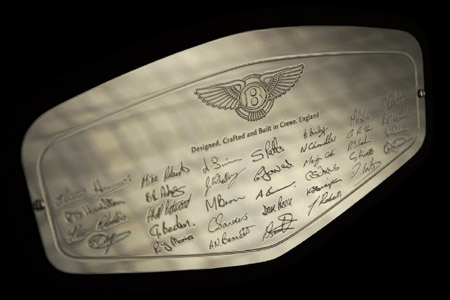
The plate fixed
inside the new Bentley showing the names of 34 staff involved
in the construction of the new car.
The Technical
Story
Crewe, 16th May
2002
Courtesy Bentley Motors
Although the Bentley State Limousine is
derived from the latest Series Two Bentley Arnage, the engineering
challenges it posed often bore no relation to those of any conventional
car. Built by a Bentley-led consortium of British motor industry
manufacturers and suppliers to celebrate the Queen's Golden Jubilee,
it will be presented as a gift to The Queen in time for its first
official duties on June 4. Designed for a minimum lifespan of
25 years and 125,000 miles, it is expected to be The Queen's
principal transport at state and ceremonial occasions.
Without the untiring support of dozens of suppliers
and contractors, the project could not have been realised. The
major partners joining Bentley Motors in the consortium are Mayflower
Vehicle Systems (bodywork), Leoni Wiring Systems (Electrics),
TWR Group (trim packaging), Radshape (brightware), Ricardo PLC
(powertrain) Intier (interior trim substrates) and MSX International
(structural analysis and validation). Bentley's responsibilities
extended to the design, styling, chassis and construction of
the car. The Bentley team has also devised, commissioned and
overseen the project from start to finish.
Innovation
The 'glasshouse' design of the rear cabin
was an area that posed questions few design teams have ever faced.
With such a large rear cabin and so much glass, the car will
potentially be subject to huge solar loadings or in other words
the build up of heat from the sun which, left unchecked, would
swiftly result in intolerable interior cabin temperatures. Normally
this issue would be at least partially addressed by fitting heavily
tinted glass but The Queen was keen that visibility both into
and out of the car was compromised as little as possible.
The solution was the fitment of laminated glass
in all windows with a reflective coating sandwiched between the
two layers. This allowed a tint of just 15 per cent and will
be barely noticeable inside or out. The tint on the roof panels
is 40 per cent.
Uprated air-conditioning is also fitted to
ensure the vast rear cabin stays cool in the hottest weather,
and without the benefit of airflow over the car while on ceremonial
duty. The average speed at which the car will travel at processional
occasions is around 9mph, though this may fall as low as 4mph.
As a result of exhaustive computer modelling and testing at the
Motor Industry Research Association (MIRA) in the UK, a system
has been devised that produces a large and slow moving mass of
cool air, distributed silently about the car.
Use of CAD Techniques
As soon as the styling of the car had been
decided, the designers set to work seeing how it could be realised
using both the latest CAD techniques and by dissecting a standard
Bentley Arnage. One weighty problem was retaining sufficient
rigidity within such a heavy car without resorting to unattractively
thick pillars. As the first Royal state limousine to use monocoque
construction rather than the body on chassis method of the Phantom
series of Rolls-Royces, the pillars are stressed members and
are required to do a lot more than merely support the roof. Once
this problem was resolved by detailed computer analysis of the
performance of certain high-grade steels, attention turned to
the execution of the rest of the design.
Statistics
Just some basic statistics give an idea
of the size of the challenge involved. At 6220mm/ 249 inches,
it is over 800mm/32 inches longer even than a standard Bentley
Arnage, while its 1770mm/70 inches height dwarfs that of the
1515mm/60 inches Arnage. Its wheelbase is 3844mm/154 inches,
not only 728mm/29 inches more than an Arnage, but also upwards
of 1.3metres/ 4.3 feet longer than that of an average sized family
saloon. Most daunting of all for the engineers was a car with
a likely kerb weight of 3390 kg/ 7474 lbs some 1400kg/ 3086 lbs.
a family saloon heavier than an Arnage.
Power and Performance
Powering the Bentley State Limousine is
a modified version of Bentley's new 400bhp, twin-turbo 6.75-litre
V8 engine that will make its debut in the recently launched Bentley
Arnage R, and, with 616lb ft/ 835 Nm of torque, endowing the
State Limousine with an impressive turn of speed right up to
its electronically limited top speed of 120mph (193km/h). Modifications
have been made to the air boxes to allow them to be fitted under
the bonnet, while a larger alternator is fitted to cope with
the added demands of the electrical system. Capable of running
on liquid petroleum gas (LPG) will not only extend the range
of the car but will also dramatically reduce its output of emissions.
The engine drives a standard four speed GM
4L80-E gearbox, as found on the Arnage, which directs power through
up rated driveshafts to the rear wheels.
Body and Suspension
The suspension for the Bentley State Limousine
is by classical double wishbones at each corner and has been
carefully honed by Bentley chassis engineers to provide the right
balance of low speed ride quality for processional events and
high speed stability.
The rear doors, hinged at the back rather than
the front to facilitate easier egress, required extensive work
before a hinging system could be found that would cope with their
weight, package effectively and allow an extraordinary 81 degree
opening.
Meeting customer requests
It would be understandable to presume a
car such as the Bentley State Limousine is brimming with every
electronic gadget available. In fact the customer's requests
have been quite specific that the car should not be filled with
such items.
Nevertheless, the highly specialised role the
car will play has necessitated the fitment of a large number
of components vital to the execution of the Head of State's duties.
Inside there is a glass division between the
front and rear compartment that can be lowered by its passengers
from a console mounted between the seats. An intercom is also
fitted.
Both rear seats are height adjustable so passengers
are seen at the same level and squarely within the rear side
window. Both rear windows can also be operated from either rear
seat. Naturally the nature of any security equipment fitted to
the car is not for public consumption.
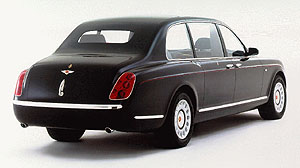
The State Bentley - A full sized
model used for design purposes prior to its completion
Our thanks to Bentley Motors
for the above pictures and information
Any
information or additional material about Windsor is always welcomed
and acknowledged.
Copies of photographs or texts
can be emailed to the Editor,
The Royal Windsor Web Site

To contact us, email Thamesweb.
|



